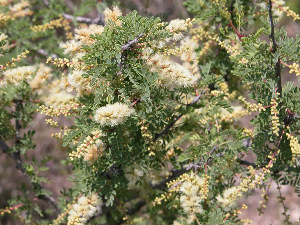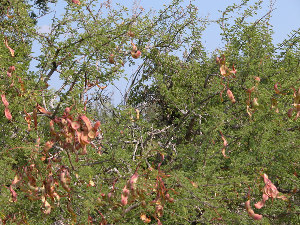Acacia
Mescat Acacia (Acacia constricta Bentham)
Huisache (Acacia farnesiana (L.) Willd.)
Catclaw or Gregg Acacia (Acacia greggii A. Gray)
Blackbrush (Acacia rigidula Benth.)
Roemer Acacia (Acacia roemeriana Scheele)
Catclaw or Wright Acacia (Acacia wrightii Benth.)
Guajillo (Acacia berlandieri Benth.)
Fabaceae (Bean or Legume Family)
Acacias are shrubs with stems armed with many straight or recurved spines. Acacia seeds (sometimes called beans) have been used as food in many places around the world. In the Lower Pecos Canyonlands, the wood was likely used for toolmaking, construction, and fuel, although no definitive archeological evidence of use has been documented, yet.
At least 7 species of Acacia grow in the region. The fruit ripens to a dry, papery or woody bean pod that ejects several seeds. The seeds furnish the food, but many species are toxic and require special processing. Some species, such as Wright and Gregg acacias, have recurved spines or prickles, and these are called catclaw acacias. Others have straight, stout spines such as blackbrush and huisache. See Cheatham et al. (1995) for detailed discussion of the uses and distribution of Acacia species found in Texas.
Archeological occurrence. Seeds and fruits of least three acacia have been observed in collections from Fate Bell Shelter, and from 5,000 to 6,000 year-old deposits in Hinds Cave (Dering 1979). Both Dering and Irving (1966) list Acacia berlandieri, Acacia rigidula, and Acacia roemeriana in the deposits of Hinds Cave and several other Lower Pecos sites. These three species have little or no mention in the ethnographies, primarily because they did not grow in the areas where the studies were conducted. Although these archeological finds demonstrate that the native peoples of the Lower Pecos Canyonlands made use of acacia for thousands of years, the exact uses have not been discerned.
Food. Acacias have a worldwide distribution and the legumes or bean pods of acacia are utilized for food on other continents, especially Australia (Smith 1989). Most acacias require processing before they can be consumed. The primary barriers to the consumption of acacia seeds are the toxins stored in them, primarily cyanogenetic glycosides that produce illness if they aren't processed properly (Kingsbury 1964). Aboriginal Australians developed techniques that involved heating, pounding, grinding, and leaching the acacia seeds, and each method was adapted to the individual species being processed (Low 1989). Although we lack detailed ethnographic descriptions of acacia processing in North America, similar techniques were doubtlessly employed by the indigenous populations of North America.
Bean and Saubel (1972:29) state that the Cahuilla collected the pods and ate them either fresh or dried. Since the mature pods are papery thin and brown, it is possible that "fresh" refers to green pods and "dried" to ripe pods. At any rate, the bitterness in the pods was reduced by parboiling them, a process involving both heating and leaching. The resulting flour was made into mush or flatcakes and consumed, much like mesquite flour (Bean and Saubel 1972:29). The Pima utilized catclaw acacias in the same manner (Russell 1908:76).
Implements, construction, and fuel. The Pima used the wood of catclaw acacia for making bows and for fuel (Curtin 1984:90). Catclaw brush also made very effective brush fences. The Cahuilla considered the wood to be outstanding for construction and firewood (Bean and Saubel 1972:29).
References:
Cheatham, Scooter, Marshall C. Johnson, and Lynn Marshall
1995 The Useful Wild Plants of Texas, the Southeastern and Southwestern United States, the Southern Plains, and Northern Mexico. Useful Wild Plants, Austin, Texas.
Bean, Lowell J. and Katherine S. Saubel
1972 Temalpakh: Cahuilla Indian Knowledge and Usage of Plants. Malki Museum Press, Morongo Indian Reservation, Banning, California.
Curtin
Leonora Scott Muse
1984 By the Prophet of the Earth: Ethnobotany of the Pima. Reprint of book published by San Vicente Foundation [1949]. University of Arizona Press, Tucson, Arizona.
Dering, J. Philip
1979 Pollen and Plant Macrofossil Vegetation Record Recovered from Hinds Cave, Val Verde County, Texas. M.S. thesis, Texas A&M University. Published by the Department of Anthropology. College Station, Texas.
Irving, Robert Stewart
1966 A Preliminary Analysis of Plant Remains from Six Amistad Reservoir Sites. In A Preliminary Study of the Paleoecology of the Amistad Reservoir Area, ed. by Dee Ann Story and V. M. Bryant, Jr., pp. 61-90. National Science Foundation Final Report (GS-667).
Kingsbury, John. M.
1964 Poisonous Plants of the United States and Canada. Prentice-Hall, Englewood Cliffs, New Jersey.
Low, Tim
1989 Bush Tucker: Australia's Wild Food Harvest. Angus and Roberson, Sydney, Australia.
Powell, A. Michael
1998 Trees and Shrubs of the Trans-Pecos and Adjacent Areas. University of Texas Press, Austin, Texas.
Russell, Frank
1908 The Pima Indians. In Twenty-sixth Annual Report of the Bureau of American Ethnology [1904-1905], pp. 17-389. Washington, D.C.
Smith, Mike A.
1989 Seed Gathering in Inland Australia: Current Evidence from Seed-grinders on the Antiquity of the Ethnohistorical Pattern of Exploitation. In Foraging and Farming The Evolution of Plant Exploitation, edited by David R. Harris and Gordon C. Hillman pp. 305-317. Unwin Hyman, London.
![]()

